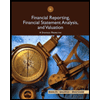
EBK FINANCIAL & MANAGERIAL ACCOUNTING
13th Edition
ISBN: 9780100545052
Author: WARREN
Publisher: YUZU
expand_more
expand_more
format_list_bulleted
Question
Chapter 12, Problem 12.5CP
1.
To determine
Earnings per share (EPS): It refers to the share of earnings earned by the shareholder on each owned. The formula to calculate the earnings per share is as follows:
To Prepare: a table indicating the expected earnings per share on the common stock under each plan.
2.
a.
To determine
To discuss: the factors that should be considered in evaluating the two plans.
b.
To determine
To explain: the plan that offers greater benefit to the present stockholders.
Expert Solution & Answer
Want to see the full answer?
Check out a sample textbook solution
Students have asked these similar questions
Pacific Retail Store purchased merchandise inventory worth $8,500 on February 15, with payment terms of 2/10, n/30 (meaning a 2% discount if paid within 10 days, otherwise the full amount is due within 30 days). If Pacific pays the invoice on February 22, how much will they pay?
I am looking for help with this accounting question using proper accounting standards.
You are a financial analyst at Beta Ltd., a company that is considering acquiring Alpha Ltd. You have been tasked to perform a discounted cash flow (DCF) valuation analysis in Excel to determine the value of the target company and advise on whether the acquisition would be financially beneficial.
The following information is provided:
1. Alpha Ltd. revenues were Sh.12.5 million. This revenue is expected to grow at a constant annual growth rate of 7.5% over the next 5 years.
2. Alpha’s Ltd. gross profit margin is 75%.
3. The target company currently has Sh.8 million in debt and Sh. 3 million in equity.
4. Selling general, administration and other expenses is expected to be 45% of sales.
5. Depreciation is expected to be 2.5% of sales.
6. Net capital expenditures are expected to be 2.5% of net revenue annually.
7. Changes in net working capital are expected to amount to Sh.500,000, Sh.600,000, Sh.700,000,…
Chapter 12 Solutions
EBK FINANCIAL & MANAGERIAL ACCOUNTING
Ch. 12 - Describe the two distinct obligations incurred by...Ch. 12 - Explain the meaning of each of the following terms...Ch. 12 - Prob. 3DQCh. 12 - A corporation issues 26,000,000 of 9% bonds to...Ch. 12 - Prob. 5DQCh. 12 - The following data relate to a 2,000,000, 8% bond...Ch. 12 - Prob. 7DQCh. 12 - Prob. 8DQCh. 12 - Fleeson Company needs additional funds to purchase...Ch. 12 - Prob. 10DQ
Ch. 12 - Prob. 12.1APECh. 12 - Prob. 12.1BPECh. 12 - Issuing bonds at face amount On January 1, the...Ch. 12 - Prob. 12.2BPECh. 12 - Issuing bonds at a discount On the first day of...Ch. 12 - Prob. 12.3BPECh. 12 - Prob. 12.4APECh. 12 - Prob. 12.4BPECh. 12 - Prob. 12.5APECh. 12 - Prob. 12.5BPECh. 12 - Prob. 12.6APECh. 12 - Prob. 12.6BPECh. 12 - Redemption of bonds payable A 1,500,000 bond Issue...Ch. 12 - Prob. 12.7BPECh. 12 - Prob. 12.8APECh. 12 - Prob. 12.8BPECh. 12 - Prob. 12.9APECh. 12 - Prob. 12.9BPECh. 12 - Prob. 12.1EXCh. 12 - Prob. 12.2EXCh. 12 - Prob. 12.3EXCh. 12 - Prob. 12.4EXCh. 12 - Prob. 12.5EXCh. 12 - Prob. 12.6EXCh. 12 - Prob. 12.7EXCh. 12 - Entries for issuing and calling bonds; loss Adele...Ch. 12 - Entries for issuing and calling bonds; gain Emil...Ch. 12 - Entries for installment note transactions On the...Ch. 12 - Prob. 12.11EXCh. 12 - Entries for installment note transactions On...Ch. 12 - Prob. 12.13EXCh. 12 - Prob. 12.14EXCh. 12 - Prob. 12.15EXCh. 12 - Prob. 12.16EXCh. 12 - Present value of amounts due Tommy John is going...Ch. 12 - Present value of an annuity Determine the present...Ch. 12 - Prob. 12.19EXCh. 12 - Prob. 12.20EXCh. 12 - Prob. 12.21EXCh. 12 - Prob. 12.22EXCh. 12 - Amortize discount by interest method On the first...Ch. 12 - Prob. 12.24EXCh. 12 - Prob. 12.25EXCh. 12 - Prob. 12.26EXCh. 12 - Prob. 12.1APRCh. 12 - Prob. 12.2APRCh. 12 - Bond premium, entries for bonds payable...Ch. 12 - Prob. 12.4APRCh. 12 - Prob. 12.5APRCh. 12 - Prob. 12.6APRCh. 12 - Prob. 12.1BPRCh. 12 - Prob. 12.2BPRCh. 12 - Prob. 12.3BPRCh. 12 - Prob. 12.4BPRCh. 12 - Prob. 12.5BPRCh. 12 - Prob. 12.6BPRCh. 12 - Prob. 12.1CPCh. 12 - Prob. 12.2CPCh. 12 - Prob. 12.3CPCh. 12 - Preferred stock vs. bonds Xentec Inc. has decided...Ch. 12 - Prob. 12.5CPCh. 12 - Prob. 12.6CP
Knowledge Booster
Learn more about
Need a deep-dive on the concept behind this application? Look no further. Learn more about this topic, accounting and related others by exploring similar questions and additional content below.Similar questions
- Hanks Company estimates its manufacturing overhead to be $450,000 and its direct labor costs to be $300,000 for year 5. Hanks worked three jobs for the year. Job 5-1, which was sold during year 5, had actual direct labor costs of $90,000. Job 5-2, which was completed but not sold at the end of the year, had actual direct labor costs of $140,000. Job 5-3, which is still in work-in-process inventory, had actual direct labor costs of $80,000. The actual manufacturing overhead for year 5 was $470,000. Manufacturing overhead is applied on the basis of direct labor costs. a) How much overhead was applied to each job in year 5? b) What was the over-or underapplied manufacturing overhead for year 5?arrow_forwardGiven solution for General accounting question not use aiarrow_forwardHelp me question and accountingarrow_forward
- Please provide the accurate answer to this general accounting problem using valid techniques.arrow_forwardI need the correct answer to this financial accounting problem using the standard accounting approach.arrow_forwardI need assistance with this financial accounting question using appropriate principles.arrow_forward
- Ming Sporting Goods had a balance in the Accounts Receivable account of $780,000 at the beginning of the year and a balance of $820,000 at the end of the year. Net credit sales during the year amounted to $6,400,000. Required: What was the average collection period of the receivables in terms of days?arrow_forwardA company produces a single product. Variable production costs are $18.2 per unit, and variable selling and administrative expenses are $6.5 per unit. Fixed manufacturing overhead totals $72,000, and fixed selling and administration expenses total $63,000. Assuming a beginning inventory of zero, production of 7,500 units, and sales of 5,200 units, the dollar value of the ending inventory under variable costing would be_.arrow_forwardPlease provide the correct answer to this accounting problem using accurate calculations.arrow_forward
arrow_back_ios
SEE MORE QUESTIONS
arrow_forward_ios
Recommended textbooks for you
 Financial AccountingAccountingISBN:9781337272124Author:Carl Warren, James M. Reeve, Jonathan DuchacPublisher:Cengage Learning
Financial AccountingAccountingISBN:9781337272124Author:Carl Warren, James M. Reeve, Jonathan DuchacPublisher:Cengage Learning Financial AccountingAccountingISBN:9781305088436Author:Carl Warren, Jim Reeve, Jonathan DuchacPublisher:Cengage Learning
Financial AccountingAccountingISBN:9781305088436Author:Carl Warren, Jim Reeve, Jonathan DuchacPublisher:Cengage Learning EBK CONTEMPORARY FINANCIAL MANAGEMENTFinanceISBN:9781337514835Author:MOYERPublisher:CENGAGE LEARNING - CONSIGNMENT
EBK CONTEMPORARY FINANCIAL MANAGEMENTFinanceISBN:9781337514835Author:MOYERPublisher:CENGAGE LEARNING - CONSIGNMENT Financial Reporting, Financial Statement Analysis...FinanceISBN:9781285190907Author:James M. Wahlen, Stephen P. Baginski, Mark BradshawPublisher:Cengage Learning
Financial Reporting, Financial Statement Analysis...FinanceISBN:9781285190907Author:James M. Wahlen, Stephen P. Baginski, Mark BradshawPublisher:Cengage Learning

Financial Accounting
Accounting
ISBN:9781337272124
Author:Carl Warren, James M. Reeve, Jonathan Duchac
Publisher:Cengage Learning

Financial Accounting
Accounting
ISBN:9781305088436
Author:Carl Warren, Jim Reeve, Jonathan Duchac
Publisher:Cengage Learning

EBK CONTEMPORARY FINANCIAL MANAGEMENT
Finance
ISBN:9781337514835
Author:MOYER
Publisher:CENGAGE LEARNING - CONSIGNMENT

Financial Reporting, Financial Statement Analysis...
Finance
ISBN:9781285190907
Author:James M. Wahlen, Stephen P. Baginski, Mark Bradshaw
Publisher:Cengage Learning
Internal Rate of Return (IRR); Author: The Finance Storyteller;https://www.youtube.com/watch?v=aS8XHZ6NM3U;License: Standard Youtube License